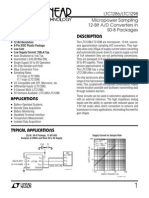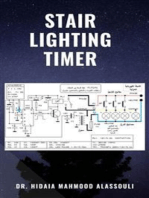313043
313043
Uploaded by
Chris AntoniouCopyright:
Available Formats
313043
313043
Uploaded by
Chris AntoniouOriginal Description:
Copyright
Available Formats
Share this document
Did you find this document useful?
Is this content inappropriate?
Copyright:
Available Formats
313043
313043
Uploaded by
Chris AntoniouCopyright:
Available Formats
Impulse Relays
Multi 9 Merlin Gerin
Modular impulse relays are bistable switches designed to control load
power mainly for lighting applications. The control orders are sent by
impulses from one or more manual control points. Built-in or add-on
auxiliary functions allow operation of latched orders or centralised and local
controls. The scope of application covers the entire building sector, from
domestic uses to industry, mainly for lighting management.
Operation
n The range is built up around the 16 A TL impulse relays (single-pole, two-
TL + ETL pole, single-pole changeover relay) and the 32 A TL impulse relay (single-
pole) which can be fitted with extensions to increase the number of poles:
o for example:
- a single-pole 16 A impulse relay + an extension becomes three-pole,
- a two-pole 16 A impulse relay + an extension becomes four-pole.
An impulse order on the coil closes the impulse relay pole or poles.
Originally designed with two stable mechanical positions, the pole or poles
are then opened by the next impulse order. Each time an impulse order is
received on the coil, the impulse relay reverses the position of the pole(s).
TLc impulse relay
The TLc incorporates centralised control while conserving the possibility of
initiating local impulse orders.
TLm impulse relay
TLc The TLm incorporates control via a latched order from a two-way switch
(changeover switch, time switch, thermostat). Manual control is inoperative.
TLs impulse relay
The TLs allows remote indication of its operating status.
Advantages
A range of efficient modular impulse relays to cover the majority of remote
control needs:
n With 16 A and 32 A ratings in a 18 mm width.
n With built-in auxiliary functions in the same space (control and indication
functions).
n With adaptable common auxiliaries.
n Compatible with all lighting types.
TLm n Consistent with the entire Multi 9 offer: matching design, same profile,
identical connections, clip-on markers, insert.
Range
TL TLI ETL TLc TLm TLs
impulse relays
with built-in
impulse relays
auxiliary
function
ATLt ATLz ATLc+c ATLc+s ATL4
TLs
impulse relay
auxiliaries TL1
TL2
M9 FP 49/A .en auxiliary
product sheet
Implementation Technical data
n Designed for installation in all modular electrical switchboards and Electrical data
enclosures. Specific to 16 A TL, TLl, ETL
n Easy to mount on symmetrical rail with bistable clip. o Power circuit:
n Easy to connect via serrated tunnel terminals with flap. o rating: ln 16 A (cos = 0.6),
n Captive screws with mixed +/- cavity. o voltage:
n Simplified clip-on addition of auxiliaries. - single-pole and two-pole: 250 V - 50/60 Hz,
three-pole, four-pole (TL+ETL): 415 V - 50/60 Hz.
n Control circuit:
Schematic Choice table o supply voltage:
- 12 to 240 V AC - 50 Hz (+6%, -15%)/60 Hz (6%)
diagrams type width rating
in mod.
voltage coil cat. no.
- 6 to 110 V DC (+6%, -10%),
L
of 9 mm V AC V DC o inrush power:
BP TL 16 A 2 16 230/240 110 15510 - single-pole and two-pole: 19 VA
1
1P 130 48 15511 - three-pole and four-pole: 38 VA.
A1
48 24 15512 n Electrical endurance:
o 200 000 AC22 cycles (cos = 0.6),
TL
24 12 15513
A2
12 6 15514 o 400 000 AC21 cycles (cos = 1).
2 2P 2 16 230/240 110 15520 Specific to TLc, TLm, TLs
R 130 48 15521 n Power circuit:
N
48 24 15522 o rating: ln 16 A,
TL o voltage: 250 V - 50/60 Hz.
24 12 15523
L 12 6 15524 n Control circuit:
BP 3P 4 16 230/240 110 15510+15530
o TLc: 24/48/230 to 240 V DC - 110 V AC,
1
130 48 15511+15531
o TLm, TLs: 230 to 240 V DC - 110 V AC.
A1
TLI 48 24 15512+15532
o Electrical endurance: 200 000 cycles.
24 12 15513+15533
Mechanical data
2 A2 n Connection: 0.5 to 6 mm2 cables.
12 6 15514+15534
n Mechanical indication on front panrel via
4
4P 4 16 230/240 110 15520+15530
operating lever position.
R R 130 48 15521+15531
N n Direct control on front face:
48 24 15522+15532
TLI o power: by ON-OFF lever,
24 12 15523+15533
o coil isolation via switch.
L
12 6 15524+15534
o Overall dimensions: h = 81; d = 64; l = 18 mm.
BP
TLI 16 A 2 16 230/240 110 15500 Electrical data for the 32 A TL
1 9
A1 1P 48 24 15502 n Power circuit:
ON/OFF 24 12 15503 o rating: ln 32 A (cos = 0.6),
TL ETL
ETL 16 A 2 16 230/240 110 15530 o voltage:
A2
2P 130 48 15531 - single-pole: 250 V - 50/60 Hz
2 10
48 24 15532 - two-pole, three-pole, four-pole: 415 V - 50/60 Hz.
N
R R
24 12 15533 o Control circuit:
TL + ETL 12 6 15534 o supply voltage:
TL 32 A 1P 2 32 230/240 110 15515 230/240 V AC - 50 Hz (+6%, -15%)/60 Hz ( 6%),
L 2P 4 15515+15505 o inrush power:
BP 3P 6 15515+2x15505 - single-pole: 19 VA, two-pole: 38 VA
11 1
A1
4P 8 15515+3x15505 - three-pole: 57 VA, four-pole: 76 VA.
TLs
ETL 32 A 1P 2 32 230/240 110 15505 n Electrical endurance:
TLc 2 16 230/240 110 15518 o single-pole: 200 000 cycles,
12 A2
48 15526 o two, three and four-pole: 100 000 cycles.
14 2
24 15525 Mechanical data for the 32 A TL
N
OFF ON R
TLm 2 16 230/240 110 15516 n Connection:
TLs 2 16 230/240 110 15517 o power circuit: cables up to 10 mm2,
TLs
o control circuit: 0.5 to 6 mm2 cables.
L n Same overall dimensions as the 16 A TL.
1
OFF ON TLm
Official approvals Environment
NF n Compliance with standards: NFC 61.110 /
ON A2 UTE CEBEC NFC 61.112 / IEC 669.1 / IEC 669.2.
OFF 2 n Tropicalisation:
N
R
K EE MU RA KEMA KEUR VE VE treatment 2 (95% relative humidity at 55C).
n Class of protection:
TLm o case: IP40,
L
NEMKO SEMKO o terminals: IP20.
BP BP
n Operating temperature:
1 1
FI SETI V
D E VDE
-20C to + 50C.
ON
BP
TLc
A1
TLc
A1
n Storage temperature:
FP48ANZ
BP
OFF -40C to +80C.
ON A2 ON A2 ASE n Switching noise level:
OFF 2 OFF 2 60 dBA (at 1 metre).
R R
N
TLc
Schneider Electric 14 Charann Pl, Avondale As standards, specifications and designs develop from time to This document was printed
Auckland, New Zealand time, always ask for confirmation of the information given in on ecological paper.
tel. +64 (09) 829 0490 this publication.
fax +64 (09) 829 0491 Publication : Communication BT-S2E
Creation, production: Sodipe (38)
DIT E D1 97 012 en
ART. 078238 04/02
You might also like
- TTi TS Series Power Supplies ManualDocument27 pagesTTi TS Series Power Supplies Manualj.bycroft126No ratings yet
- AWT Fundamentals and Applications Cooling Water Training: Towers, Chillers and LoopsDocument38 pagesAWT Fundamentals and Applications Cooling Water Training: Towers, Chillers and LoopsMunir AbdullahNo ratings yet
- Modulo Eletr - Proporcional RexrothDocument4 pagesModulo Eletr - Proporcional Rexrothpcramos007No ratings yet
- TEA1024Document8 pagesTEA1024piotreNo ratings yet
- T2117 Zero-Voltage Switch With Adjustable Ramp PDFDocument16 pagesT2117 Zero-Voltage Switch With Adjustable Ramp PDFnenadNo ratings yet
- Zero-Voltage Switch With Adjustable Ramp T2117: FeaturesDocument15 pagesZero-Voltage Switch With Adjustable Ramp T2117: FeaturesNenad VukovicNo ratings yet
- Datasheet TSM LC25 50 V12Document4 pagesDatasheet TSM LC25 50 V12kamal anlaNo ratings yet
- LM5025B Active Clamp Voltage Mode PWM Controller: Literature Number: SNVS354ADocument18 pagesLM5025B Active Clamp Voltage Mode PWM Controller: Literature Number: SNVS354AbpchimeraNo ratings yet
- PL SeriesDocument49 pagesPL Seriesgoogle manNo ratings yet
- Fun Projects 23 Chapter PDFDocument6 pagesFun Projects 23 Chapter PDFtihomihoNo ratings yet
- LABOUR Rate For Cont. 30.05.16 (Approved by Iftkhar)Document49 pagesLABOUR Rate For Cont. 30.05.16 (Approved by Iftkhar)braj bhushanNo ratings yet
- Water Level ControllerDocument7 pagesWater Level ControllerYudi Mahato0% (1)
- Clap SwitchDocument14 pagesClap SwitchAkilesh ArigelaNo ratings yet
- RF - PA - 250 - 3 - HV - V300 180W PA KIT CONSTRUCTION (English)Document15 pagesRF - PA - 250 - 3 - HV - V300 180W PA KIT CONSTRUCTION (English)Luiz Luiz100% (1)
- 2 038 PDFDocument11 pages2 038 PDFAmit GauravNo ratings yet
- TH3122 004 PDFDocument14 pagesTH3122 004 PDFSasa MitrovicNo ratings yet
- Experiment 1: Linear Power SuppliesDocument9 pagesExperiment 1: Linear Power SuppliesŞems TanriverdiNo ratings yet
- 61f-An - Apn2 Ds e 4 1 csm2 PDFDocument18 pages61f-An - Apn2 Ds e 4 1 csm2 PDFMay NopparatNo ratings yet
- DC-DC Converter Control Circuits: Description DIP-8Document16 pagesDC-DC Converter Control Circuits: Description DIP-8Krittapop SaleechanNo ratings yet
- DC-DC Converter Control Circuits: Description DIP-8Document15 pagesDC-DC Converter Control Circuits: Description DIP-8Полецкий ОлегNo ratings yet
- ARBO SA. COMMISSIONING - ARBO SE-WLS220-2,1-08 ElektronikaDocument8 pagesARBO SA. COMMISSIONING - ARBO SE-WLS220-2,1-08 ElektronikaTBF1DNo ratings yet
- A1302 - Sensor de Efeito Hall Linear PDFDocument10 pagesA1302 - Sensor de Efeito Hall Linear PDFRicardoNo ratings yet
- A6F10H A2X6F10H Switching ActuatorDocument2 pagesA6F10H A2X6F10H Switching ActuatorMarkos StavropoulosNo ratings yet
- File For Transformer Safety DeviceDocument21 pagesFile For Transformer Safety Devicebalajichoicecentar100% (1)
- 150 Watt Single Bander 1957Document8 pages150 Watt Single Bander 1957Domingos SanchezNo ratings yet
- YEA KAEPS800000042K SGDV DC WiringDocument7 pagesYEA KAEPS800000042K SGDV DC WiringZon Zon GamingTMNo ratings yet
- VR 448 ManualDocument8 pagesVR 448 ManualAbdul KhaliqNo ratings yet
- HT PanelDocument9 pagesHT PanelPRABHAT YADAVNo ratings yet
- S G M BH: Phase Control Circuit For Industrial ApplicationsDocument11 pagesS G M BH: Phase Control Circuit For Industrial ApplicationsMiguel Angel GullonNo ratings yet
- HAUG Power Pack EN SL LCDocument2 pagesHAUG Power Pack EN SL LCArief Josep ChandraNo ratings yet
- LM311 PDFDocument31 pagesLM311 PDFMANGAL KUMAR MOHAPATRANo ratings yet
- LM111-N/LM211-N/LM311-N Voltage Comparator: FeaturesDocument32 pagesLM111-N/LM211-N/LM311-N Voltage Comparator: FeaturesBrigith MamaniNo ratings yet
- TL494 TutorialDocument14 pagesTL494 Tutorialwizardgrt1No ratings yet
- Conveyor PeripheralDocument8 pagesConveyor PeripheralKandang DownloadNo ratings yet
- XL1509 DatasheetDocument13 pagesXL1509 DatasheetMantasPuskoriusNo ratings yet
- Panel Accessories Catalog 1.2Document159 pagesPanel Accessories Catalog 1.2HARISH SHARMANo ratings yet
- S Feature D Escriptio: LTC1163/LTC1165 Triple 1.8V To 6V High-Side MOSFET DriversDocument8 pagesS Feature D Escriptio: LTC1163/LTC1165 Triple 1.8V To 6V High-Side MOSFET DriversPablo LloveraNo ratings yet
- LM - 388Document10 pagesLM - 388marcelo giussaniNo ratings yet
- 1SBH143001R8753 Nl53e 125 V DCDocument4 pages1SBH143001R8753 Nl53e 125 V DCTurnerNo ratings yet
- Pe LabDocument24 pagesPe Labajay639998No ratings yet
- MC34063ACDocument16 pagesMC34063ACN DYNAMICPURUSOTHNo ratings yet
- Datasheet - 802 Series PDFDocument4 pagesDatasheet - 802 Series PDFAndrew MorrisonNo ratings yet
- AN0038BDocument3 pagesAN0038BNick BakkerNo ratings yet
- LM386 DatasheetDocument6 pagesLM386 DatasheetJamie ValentineNo ratings yet
- U217B/ U217B-FP: Zero Voltage Switch With Adjustable RampDocument11 pagesU217B/ U217B-FP: Zero Voltage Switch With Adjustable RampvalkovNo ratings yet
- Contact Block EatonDocument2 pagesContact Block EatonsydifiaNo ratings yet
- Chapter 1 PLC Ladder Diagram and The Coding Rules of MnemonicDocument15 pagesChapter 1 PLC Ladder Diagram and The Coding Rules of Mnemonicmoney_kandan2004No ratings yet
- 1change Over RelayDocument2 pages1change Over RelayPrabhavathi RamasamyNo ratings yet
- FiDocument24 pagesFishhmmmNo ratings yet
- LM 567Document9 pagesLM 567Juan Chin Pérez GarcíaNo ratings yet
- A1301 2 Datasheet PDFDocument10 pagesA1301 2 Datasheet PDFzeze1982No ratings yet
- Datasheet LTC1286 FsDocument25 pagesDatasheet LTC1286 FsRamonNo ratings yet
- CN6000Document3 pagesCN6000dwijokopurnomo21_362No ratings yet
- HPL 430 DatasheetDocument2 pagesHPL 430 DatasheetCarlos Guille MoragaNo ratings yet
- 63 TV LG 21FJ8RL No PrendeDocument16 pages63 TV LG 21FJ8RL No PrendeJuan UrbinaNo ratings yet
- Variable Power Supply: Ideal For The Small WorkshopDocument5 pagesVariable Power Supply: Ideal For The Small WorkshopJorge Manuel Marques VitorinoNo ratings yet
- VF1827-00 Elite XT Wiring Diagram - E07.14Document20 pagesVF1827-00 Elite XT Wiring Diagram - E07.14engkffNo ratings yet
- Hand Book Ver. No. Ver. No. 0111SB03.1: S&T Training Centre, Podanur Iso 9001-2008 Certified UnitDocument57 pagesHand Book Ver. No. Ver. No. 0111SB03.1: S&T Training Centre, Podanur Iso 9001-2008 Certified Unitsampreethp100% (1)
- Jagan Gopala - 08.08Document110 pagesJagan Gopala - 08.08Sravan CholeteNo ratings yet
- Reference Guide To Useful Electronic Circuits And Circuit Design Techniques - Part 1From EverandReference Guide To Useful Electronic Circuits And Circuit Design Techniques - Part 1Rating: 2.5 out of 5 stars2.5/5 (3)
- Inst Iec617 Doc18Document14 pagesInst Iec617 Doc18Chris AntoniouNo ratings yet
- GMC Application LanguageDocument3 pagesGMC Application LanguageChris AntoniouNo ratings yet
- An Improved Data Stream Summary: The Count-Min Sketch and Its ApplicationsDocument18 pagesAn Improved Data Stream Summary: The Count-Min Sketch and Its ApplicationsChris AntoniouNo ratings yet
- PDF NMSC Brochure Tips Installing Nav Lights PDFDocument3 pagesPDF NMSC Brochure Tips Installing Nav Lights PDFChris AntoniouNo ratings yet
- PDF NMSC Brochure Tips Installing Nav Lights PDFDocument3 pagesPDF NMSC Brochure Tips Installing Nav Lights PDFChris AntoniouNo ratings yet
- A Sketch Interface To Support Storyboarding of Augmented Reality ExperiencesDocument1 pageA Sketch Interface To Support Storyboarding of Augmented Reality ExperiencesChris AntoniouNo ratings yet
- Sketch PDFDocument1 pageSketch PDFChris AntoniouNo ratings yet
- AVA Microchip Protocols2Document12 pagesAVA Microchip Protocols2Chris AntoniouNo ratings yet
- Aua Symptom ScoreDocument8 pagesAua Symptom ScoreChris AntoniouNo ratings yet
- A Sketch Interface To Support Storyboarding of Augmented Reality ExperiencesDocument1 pageA Sketch Interface To Support Storyboarding of Augmented Reality ExperiencesChris AntoniouNo ratings yet
- 1002T-20Control Panel GBDocument1 page1002T-20Control Panel GBChris AntoniouNo ratings yet
- School'S Balanced Reading Program: Bula National School of FisheriesDocument3 pagesSchool'S Balanced Reading Program: Bula National School of FisheriesJohn Nathaniel CafeeNo ratings yet
- Net Banking: by Vinod KambleDocument15 pagesNet Banking: by Vinod KambleVinod KambleNo ratings yet
- DS2000 Data Server: Technical White PaperDocument13 pagesDS2000 Data Server: Technical White Paperhuzvn82_622938820No ratings yet
- Mar5 Physics Formulas PDFDocument6 pagesMar5 Physics Formulas PDFlmlNo ratings yet
- Dot Matrix Led DisplayDocument6 pagesDot Matrix Led DisplayDipesh PatelNo ratings yet
- Circuiting GuidelinesDocument8 pagesCircuiting GuidelinesHikaru babieraNo ratings yet
- Team TeachingDocument8 pagesTeam Teachingapi-316017955No ratings yet
- Bowling LP 3 7th GradeDocument4 pagesBowling LP 3 7th GradeJules BarrassoNo ratings yet
- Ilovepdf MergedDocument3 pagesIlovepdf MergedBrian MaunduNo ratings yet
- Patient Information and Billing System For Northern Balayan HospitalDocument11 pagesPatient Information and Billing System For Northern Balayan HospitalArgine Tosing SecretoNo ratings yet
- School BooksDocument192 pagesSchool BooksGANAPATHY.SNo ratings yet
- 10 Sa1 English Sample Paper2Document11 pages10 Sa1 English Sample Paper2ashmitharajaNo ratings yet
- Abdulrhaman Morsi - CVDocument2 pagesAbdulrhaman Morsi - CVahmedkamalkimo92No ratings yet
- AI-09-Resolution in FOLDocument35 pagesAI-09-Resolution in FOLpany p.gNo ratings yet
- Ho MPri Bruning14Document4 pagesHo MPri Bruning14varra unrealNo ratings yet
- Market Data ArchitectureDocument38 pagesMarket Data Architecturemelfamania100% (1)
- A Simplified Method For Cholesterol Determination in Meat and Meat ProductsDocument9 pagesA Simplified Method For Cholesterol Determination in Meat and Meat ProductsMiguelcuevamartinezNo ratings yet
- Hire Purchase, Lease, and Instalment Purchase SystemDocument10 pagesHire Purchase, Lease, and Instalment Purchase SystemVipin Mandyam KadubiNo ratings yet
- No.10 - Yard Service AirDocument1 pageNo.10 - Yard Service AirAdetunji TaiwoNo ratings yet
- internal practical report on blowersDocument24 pagesinternal practical report on blowersharishdangi.51No ratings yet
- Javaone2016javaflamegraphs 160920172322Document71 pagesJavaone2016javaflamegraphs 160920172322csy365No ratings yet
- Central AsiaDocument3 pagesCentral AsiaGraceNo ratings yet
- VowelsDocument3 pagesVowelsanglicusNo ratings yet
- BLOWENGINEERING PLASTIC MACHINES Blow Molding Machine Manufacturer PDFDocument6 pagesBLOWENGINEERING PLASTIC MACHINES Blow Molding Machine Manufacturer PDFJoenetDarmawanNo ratings yet
- Patreon Case StudyDocument7 pagesPatreon Case StudyDengStaMariaNo ratings yet
- Microsoft Training and Certification Poster (July 2019) PDFDocument1 pageMicrosoft Training and Certification Poster (July 2019) PDFAnugerahSentotSudonoNo ratings yet
- CdosDocument24 pagesCdosrkarlinNo ratings yet
- Seminar (Cylinder Deactivation)Document3 pagesSeminar (Cylinder Deactivation)dinuNo ratings yet
- Print Student Visa - GOV - UkDocument19 pagesPrint Student Visa - GOV - UkTushar SoniNo ratings yet


































































































